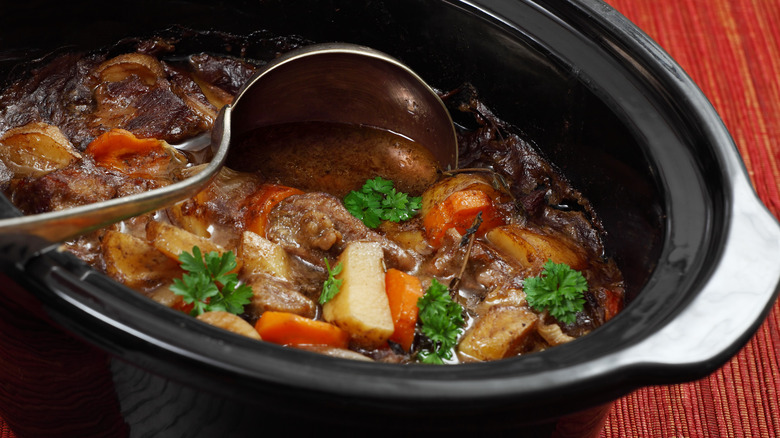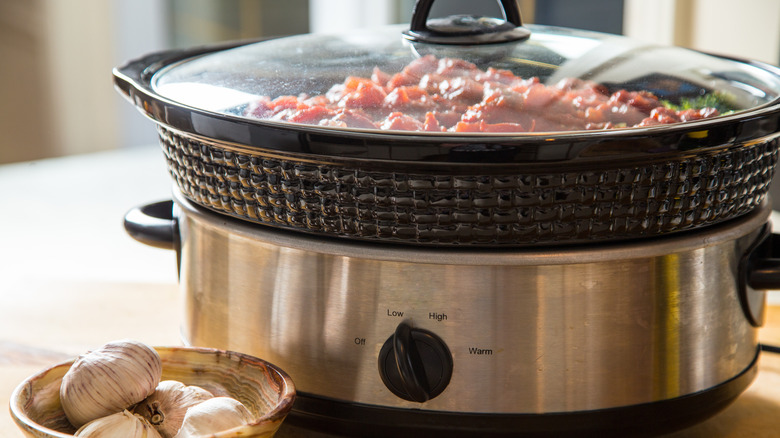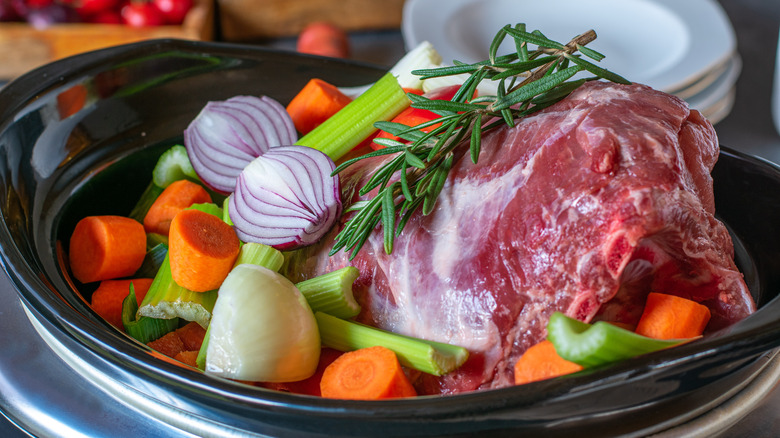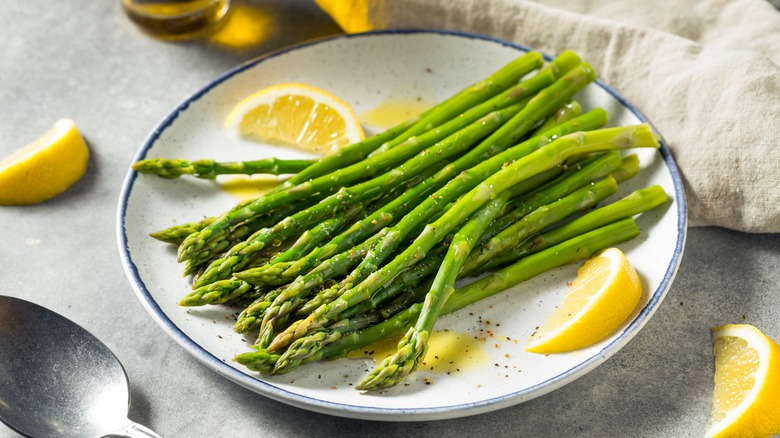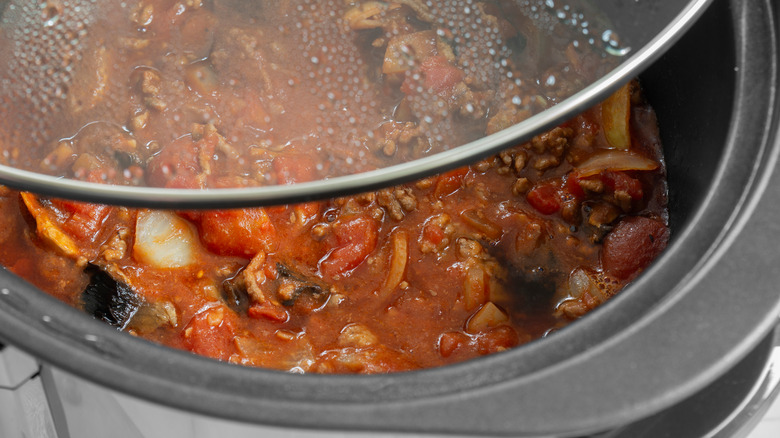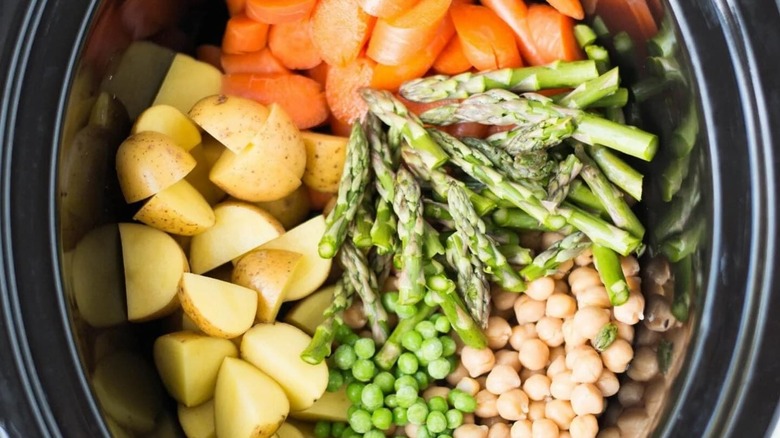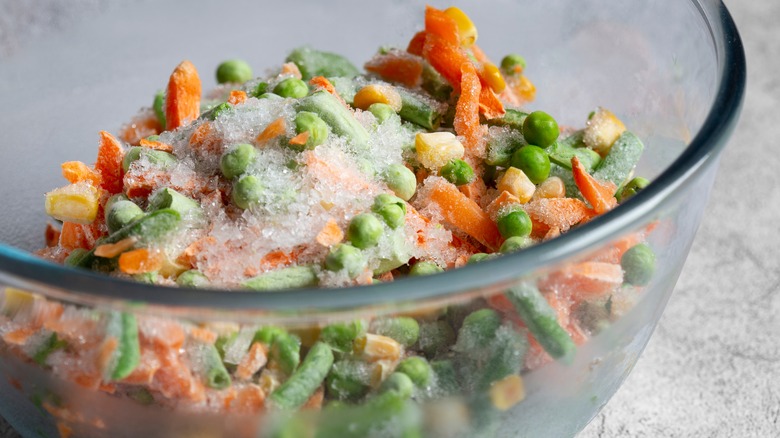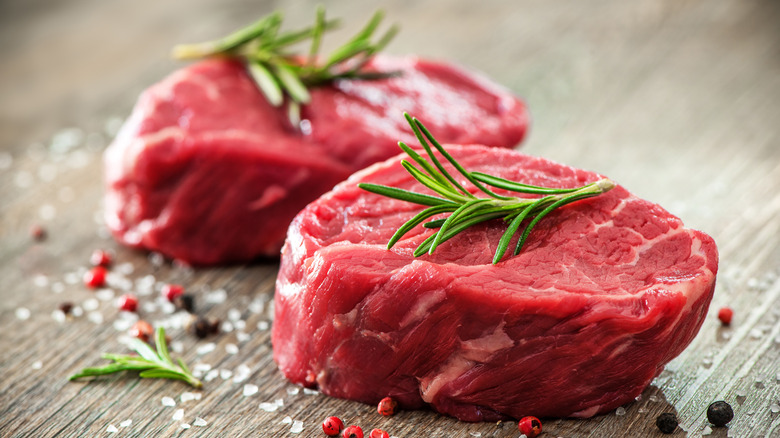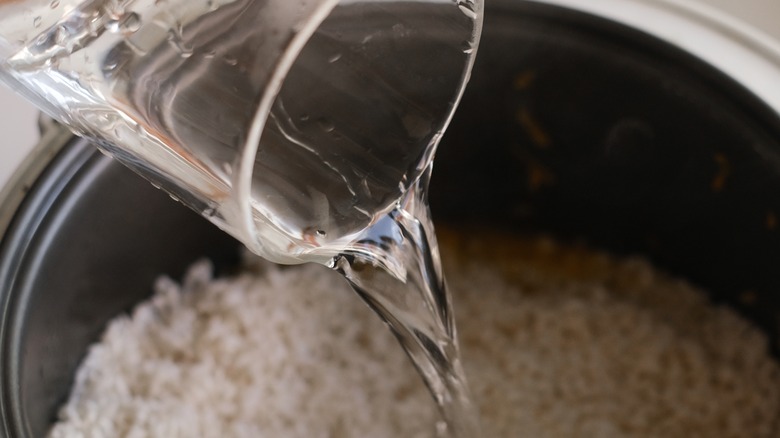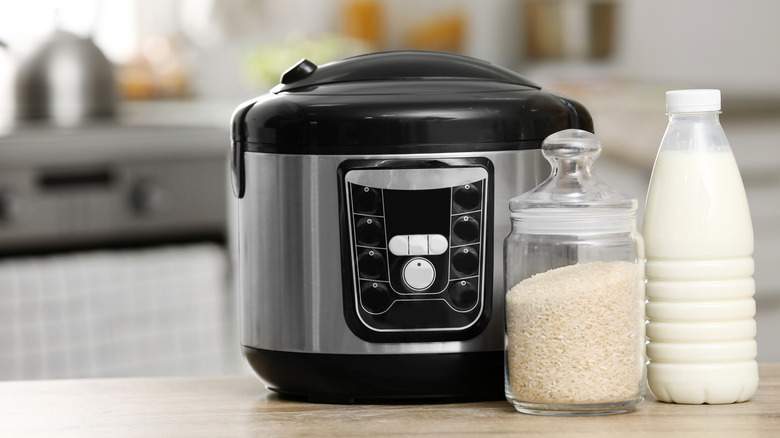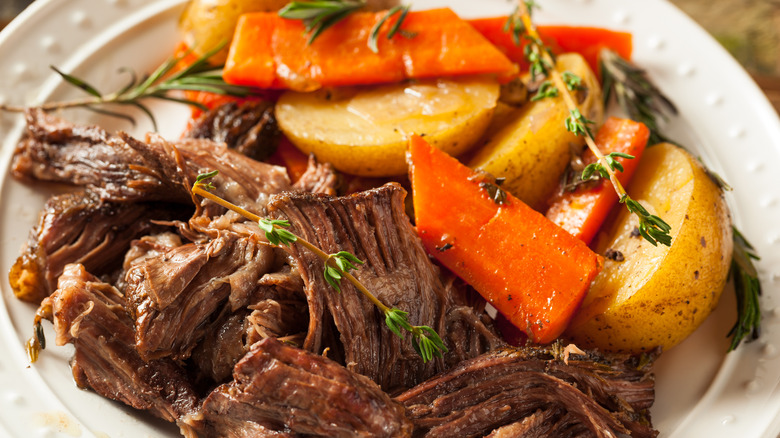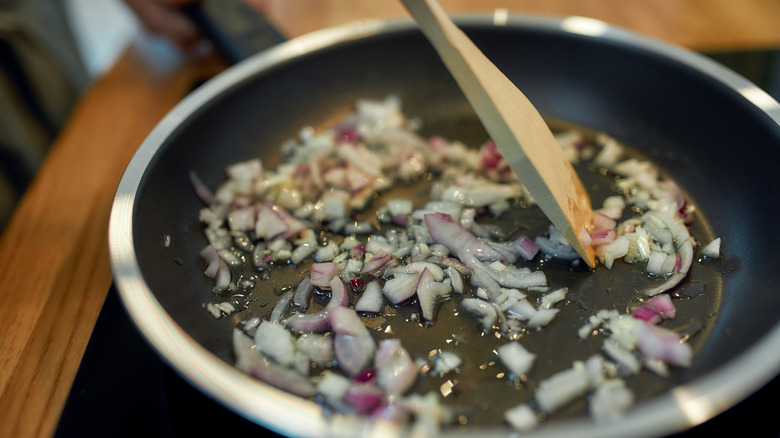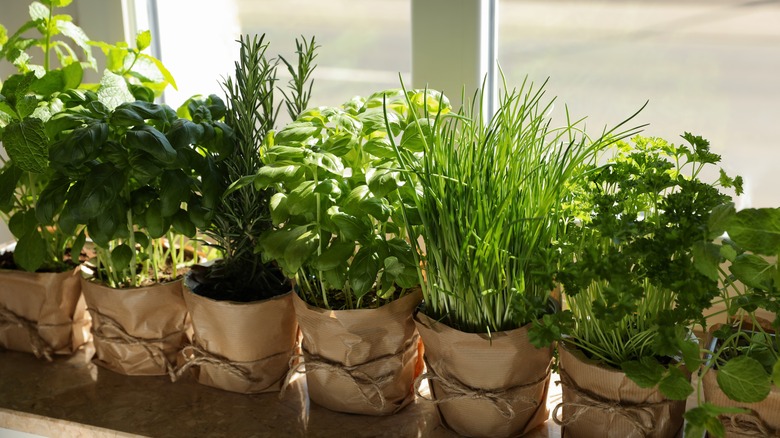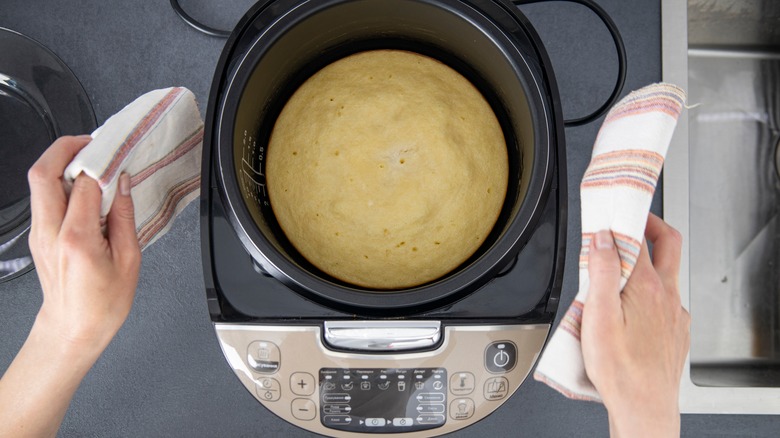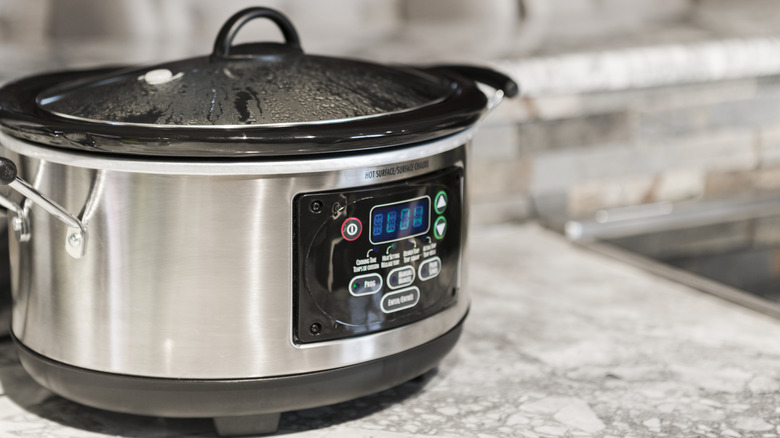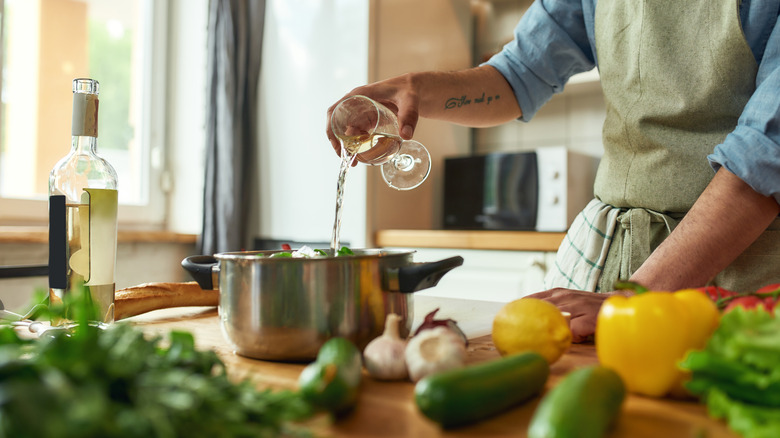The Top 15 Slow Cooker Mistakes To Avoid
If there is one appliance that has transformed meal preparation and changed the lives of time-poor home cooks everywhere, it has to be the slow cooker. The ability to start your meal prep before you leave the house in the morning and return to a fully cooked meal is a revelation. However, even experienced cooks may be making mistakes with their slow cooker that are potentially wasting time and negatively affecting the quality of the food.
Join us as we uncover the most common slow cooker mistakes that may be churning out disappointing results, from overfilling the pot to adding delicate ingredients at the wrong time. If you've been wondering why your casseroles are so watery or your fresh herbs have lost their vibrant flavor, read on. By steering clear of these common slip-ups you can be sure your slow cooker is creating the best possible meals for you to return home to after a long and tiring day.
1. Putting too much in your slow cooker
Coming home from work at the end of the day to a perfectly cooked meal is such a wonderful prospect. You may be tempted to take advantage of the situation by adding as much to your slow cooker as possible, thinking you'll have enough food to last a few days. Unfortunately, overfilling the slow cooker could result in a dish that is not cooked evenly, potentially ruining your whole meal.
There are two main issues with filling your pot to the top. First, the liquid in the pot could begin to bubble over, meaning the outside of the cooker will be coated in sauce, leaving a burnt-on mess to clean up later. The second issue is that there needs to be space within the slow cooker for the heat to circulate and allow the food at the bottom and top to cook equally. By stuffing the slow cooker to the brim you may cause some of the food to overcook while other parts will be underdone.
As a general rule, filling your slow cooker halfway to three-quarters full will get you the best results. Next time you're tempted to squeeze in just a little more, save yourself a culinary disaster by remembering that less is more.
2. Cooking meat on a high setting
When you're setting up your slow cooker to prepare a delicious meal, you may sometimes be tempted to press the 'high heat' button to help things along and make sure your meat isn't undercooked when you come home from work. This is not actually the best option, and patience will pay off when it comes to making a meal in a slow cooker.
The meats that benefit from slow-cooking are the tougher cuts such as brisket and lamb shoulder. That's because the collagen in the meat needs to break down, which takes time. A low heat applied for an extended period of time will allow the proteins in the collagen to unravel and result in beautifully tender meat that will not require much chewing.
The meat will absorb flavors from any sauce that you've added to the pot, meaning the depth of flavor will be more delicious the longer and slower it cooks. So don't be tempted to crank up the heat for fear of the meat being underdone. Trust in the process and give the meat the time it needs to do its thing and break down into a mouthwatering soft and tender feast.
3. Adding spring vegetables too early
Slow cooking is often advertised as a chuck-it-all-in-the-pot-at-once method of cooking, which makes it an appealing choice for many of us. While there are certain situations where this is the case, adding all vegetables at the same time can be a recipe for a mushy mess by the end of the cooking time. Tender vegetables, such as asparagus, peas, and leafy greens, should add a splash of vibrancy to your dish with their bright colors, but cooking them for a long time will rob them of their vitality. Instead, cook the rest of your dish and add any delicate vegetables toward the end of the process to help them keep their shape and fresh flavor.
Root vegetables, on the other hand, really benefit from slow cooking and should be added to the slow cooker at the start along with the meat and other ingredients. Onions, potatoes, and carrots should be cut into large, equally-sized chunks to ensure they cook evenly and don't dissolve into pulp.
4. Removing the lid during cooking
Slow cooking is a long game, and patience is crucial if you want to end up with a delicious, perfectly cooked meal. The extensive time means that the build-up of heat is an important part of the cooking process, so keeping the lid on the pot whenever possible is a must. Though it may be tempting to have a peek at your dish or even take a taste, you must resist the temptation to lift the lid of the slow cooker. Even when it's just for a few seconds, removing the lid can cause the temperature to cool by as much as 15 degrees Fahrenheit, and can add 30 minutes extra to your cooking time.
The good news is that most cookers have a glass lid, meaning you can check how your dish looks without that precious steam escaping. You can also monitor liquid levels and make sure your dish isn't burning without slowing down the cooking. If you do need to add anything to the pot, such as extra stock or tender vegetables, replace the lid as soon as you can to allow the slow cooker to return to bubbling away as quickly as possible.
5. Adding the ingredients in any order
While it may be tempting to chuck all of your ingredients into the slow cooker at the same time, in any order, there is a method to when and where each ingredient should go. Taking a few minutes at the start to organize things properly will save you the disappointment of undercooked or overcooked food later.
Root vegetables take the longest to cook, so they should go in first. The last thing you want is rock-hard carrots or potatoes at the end of hours of cooking. Vegetables such as onions and peppers that can handle long cooking times can go on top of the root vegetables, with meat or fish on top of them.
The last items to go in the slow cooker should be tender veggies such as tomatoes, asparagus, or leafy greens, as well as fresh herbs. These ingredients don't need much time cooking at all, so they should usually be added later in the process. By arranging your ingredients properly, you will avoid having undercooked potatoes or unrecognizable mush, and will instead have a perfectly cooked meal to return home to at the end of the day.
6. Cooking frozen foods in the slow cooker
Slow cookers are brilliant gadgets to have in your kitchen to save you time and effort. With this in mind, it's tempting to think that throwing ingredients straight from the freezer into the cooker will make the process even easier. Unfortunately, this is not advisable, and could even be dangerous.
While cooking food straight from the freezer in the oven is safe in most cases, the slow cooker's low temperature makes it a different situation entirely. The danger zone for bacteria is between 40 and 140 degrees Fahrenheit. Between these temperatures, bacteria can multiply rapidly, meaning food can spoil or even cause illness. The less time food spends in this temperature range, the better, but with slow cookers, it will spend too long in this dangerous temperature zone as it incrementally heats up from frozen to cooked. The safest option is to thaw your food overnight in the fridge before adding it to the slow cooker, keeping your ingredients out of the danger zone and keeping everyone safe and well-fed.
7. Using expensive cuts of meat
One of the huge benefits of slow cooking, apart from the convenience, is that it can save you money on ingredients, particularly meat. While you may usually choose high-quality, expensive cuts of meat when cooking on the stovetop or in the oven, slow cooking is actually better suited to less expensive cuts of meat.
These cheaper cuts contain lots of collagen, as they are usually from the parts of the animal that have lots of muscle and move around regularly. If you try to cook this kind of meat quickly in a frying pan, it will be extremely tough and unpleasant to eat. However, if you cook it slowly at a low temperature, the proteins in the collagen will melt down and create a tender dish that will fall apart easily.
Chuck roast, pork shoulder, and ribs are great options, allowing you to create tender, flavorsome meat-based dishes for your family without breaking the bank. Save the filet mignon and lamb chops for another time, and give the under-appreciated cuts of meat a chance to shine.
8. Using the wrong amount of liquid
Although slow cooking is a very hands-off method of preparing your meals — you can literally go to work and leave your dinner cooking all day — getting the volume of liquid right is crucial to ensure things go smoothly. Adding either too much or too little could leave you with a disappointing meal and potentially a difficult mess to clean up.
One of the big advantages of a slow cooker is that you don't need to stand over the food and make sure it doesn't burn. However, not adding enough liquid to the pot before turning it on could result in food becoming stuck to the bottom of the pot. Although the rate of evaporation is much lower in a slow cooker, if you have very little liquid to begin with, the food could start to burn and stick to the pot, leaving a lot of scrubbing to be done afterward.
On the other hand, adding too much liquid can leave your dish tasting washed out and with a soggy texture. Compared to cooking on the stovetop, where steam is constantly escaping, your dish will be left with much more of the original liquid. If you are adapting a recipe for the slow cooker, use about half the amount of liquid that the original recipe suggests. If you're unsure, add just enough to cover the ingredients.
9. Adding dairy too early
Though the vegetables and meat in your recipes can benefit from hours of slow cooking, giving the same treatment to your dairy products will result in a curdling catastrophe. Milk, cream, and yogurt are not really fans of the heat, and will separate out, spoiling your dish by creating an unpleasant texture and sharp flavor.
Curdling occurs more quickly when milk is heated because it causes the proteins to attract each other and form curds. If you are making cheese, this is exactly what you want to happen, but not so much if you are making a creamy sauce. To prevent this particular disaster, add your dairy during the last 30 minutes or so of slow cooking, or even at the very end if you don't really need it to cook much. This means you'll get the luscious, creamy texture you desire, without having to worry about unexpected grainy lumps or negatively affected flavor.
10. Using your slow cooker to reheat leftovers
If you've made enough food in your slow cooker to have leftovers, you can store them in an airtight container and keep them in the fridge for the following day. However, when it comes time to reheat those leftovers, you should not put them back in the slow cooker.
Apart from the fact that it would take quite a while to heat your food back up to temperature compared to a microwave or oven, reheating in a slow cooker encourages the growth of bacteria. When reheating food, you want to get the temperature up to at least 165 degrees Fahrenheit as quickly as possible. Slow cookers take a while to do this, leaving your food in the danger zone for too long. Instead, transfer your leftovers straight from the fridge to the oven, microwave, or stovetop, and leave your slow cooker to do what it does best — the initial cooking.
11. Not sauteeing vegetables before slow cooking
If you want your slow cooking experience to be as simple as possible, you can absolutely toss in all of your ingredients raw and leave the cooker to do its work. If you want to get the best possible flavor into your dish, though, a little bit of work beforehand can make a huge difference.
Sauteeing your aromatics before slow cooking is a great way to boost the flavor of your meal. Aromatics are the ingredients that form the base of a sauce or stew, such as garlic, onions, carrots, and celery. By sauteeing them in a hot pan with oil, these ingredients will have the chance to cook at a higher temperature and begin to brown, taking part in the Maillard reaction.
Sauteeing dramatically changes the taste compared to slowly heating them in a liquid, meaning the process improves the depth of flavor in the dish, and continues to impart this flavor to the sauce as the whole thing cooks slowly. By taking a few minutes at the start of your meal preparation, you can create more robust flavors that take your final dish to a new level.
12. Adding tender fresh herbs at the start
As any enthusiastic home cook knows, adding fresh and dried herbs to your food is a great way to lift the flavors and create vibrancy in your dish. However, when slow cooking, the time at which you add the herbs is crucial.
Tender herbs, such as fresh basil, cilantro, and parsley have delicate leaves that don't cope well with too much heat. These herbs should be added as close to the end of cooking as possible to help retain their vibrant flavor and color, even after the point at which you would add tender vegetables. Either add the herbs during the last ten minutes of cooking or simply stir them into the dish after it has cooked.
Woody herbs such as fresh rosemary or thyme can cope with a longer cooking time and can be added at the start along with the rest of your ingredients. This will give their flavors time to develop and enhance your dish. Dried herbs work in a similar way, benefiting from a few hours spent simmering away in the sauce. By strategically planning the addition of herbs to your slow cooker, you can make sure you get the best out of these wonderful flavor boosters.
13. Not greasing the slow cooker when baking
It may not have occurred to you to use your slow cooker for baked goods, but it is a wonderful way to make moist cakes and bread. But keep in mind that if you fail to grease the cooker beforehand, you will be left with a sticky mess that will take an age to clean up.
The simplest way to grease the inside of the chamber is to use an oil spray to make sure you coat all sides. Alternatively, you could use a pastry brush to apply oil or butter around the inside. You can then pour your cake batter or cookie dough straight into the slow cooker, confident that it will slide out beautifully after cooking. Make sure to leave enough space for your creation to rise without hitting the lid.
If you don't fancy pouring your mixture straight in, you can use a baking tin to keep your cake contained, which you can lift straight out once the cake has cooked. Just remember to grease that too!
14. Placing your slow cooker directly on the countertop
Though slow cookers offer a very safe way to prepare your meals, they generate a lot of heat, which can be problematic depending on where you place them in the kitchen. Placing your appliance directly on the countertop could cause the countertop to warp or crack, depending on the material it's made from. Because you're potentially leaving your slow cooker on all day while the house is empty, it's important to know before you go that the surface it rests on is completely safe. Certain surfaces may not be as fully heat-resistant as you would expect, meaning you shouldn't leave the slow cooker unattended on these countertops.
To protect your surfaces and put your mind at ease, place your slow cooker on a surface designed for extremely hot items such as pots and pans. A trivet or heat-resistant mat designed to withstand high temperatures and protect the worktops beneath is ideal. If you don't have a dedicated heat-resistant surface, simply place the slow cooker on the stovetop. Just make sure to never turn on the stove while the appliance is sitting on top of it.
15. Cooking with alcohol
Adding a splash of wine to a risotto or sauce is a great way to add flavor to a dish, knowing the alcohol will reduce as you cook and leave a subtle note behind. Things are different when you add alcohol to a slow cooker dish; the method requires a lighter touch or the alcohol will overpower the dish.
The sealed nature of the slow cooker means that the alcohol will not evaporate in the same way as it would on the stovetop. So whatever wine, beer, or cider you add at the beginning will still be present in the finished dish. If the alcohol is crucial to your dish — after all you can't have a coq au vin without the vin — then you may want to consider starting the sauce on the stovetop and then transferring it to the slow cooker. This will allow the alcohol to mellow in flavor before it spends a few hours simmering on a low heat with the rest of your dish. Ultimately, this will result in more balanced flavors overall.

